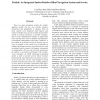PERCOM
2004
ACM
15 years 3 days ago
2004
ACM
In this paper, we analyze the role of the social group in a Ubiquitous Computing (Ubicomp) environment as a source of contextual information. A model is presented to address the s...
PERCOM
2004
ACM
15 years 3 days ago
2004
ACM
With the advent of tiny networked devices, Mark Weiser's vision of a world embedded with invisible computers is coming to age. Due to their small size and relative ease of dep...
PERCOM
2004
ACM
15 years 3 days ago
2004
ACM
A framework for the dynamic aggregation of ubiquitous computers is presented. The framework aggregates applications from more than one mobile component that can migrate from compu...
PERCOM
2004
ACM
15 years 3 days ago
2004
ACM
There are many navigation systems for visually impaired people but few can provide dynamic interactions and adaptability to changes. None of these systems work seamlessly both ind...
PERCOM
2004
ACM
15 years 3 days ago
2004
ACM
In distributed systems, transcoding techniques have been used to customize multimedia objects, utilizing trade-offs between the quality and sizes of these objects to provide diffe...
PERCOM
2004
ACM
15 years 3 days ago
2004
ACM
Large sensor networks in applications such as surveillance and virtual classrooms, have to deal with the explosion of sensor information. Coherent presentation of data coming from...
PERCOM
2004
ACM
15 years 3 days ago
2004
ACM
PERCOM
2004
ACM
15 years 3 days ago
2004
ACM
Using a networked infrastructure of easily available sensors and context-processing components, we are developing applications for the support of workplace interactions. Notions o...
PERCOM
2004
ACM
15 years 3 days ago
2004
ACM
We present MediaBroker, a distributed framework designed to support pervasive computing applications. Specifically, we propose an architecture consisting of a transport engine and...
PERCOM
2004
ACM
15 years 3 days ago
2004
ACM
Sleep deprivation attacks are a form of denial of service attack whereby an attacker renders a pervasive computing device inoperable by draining the battery more quickly than it w...





